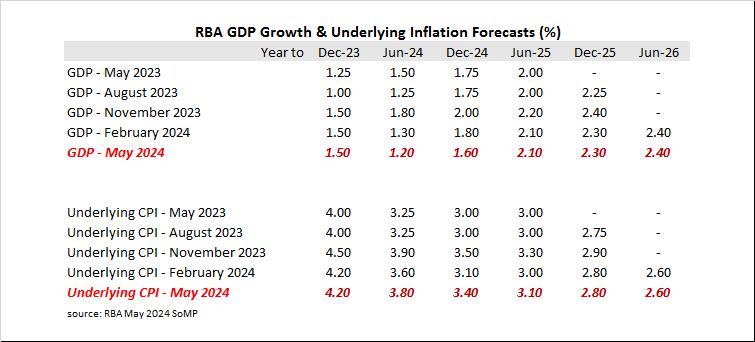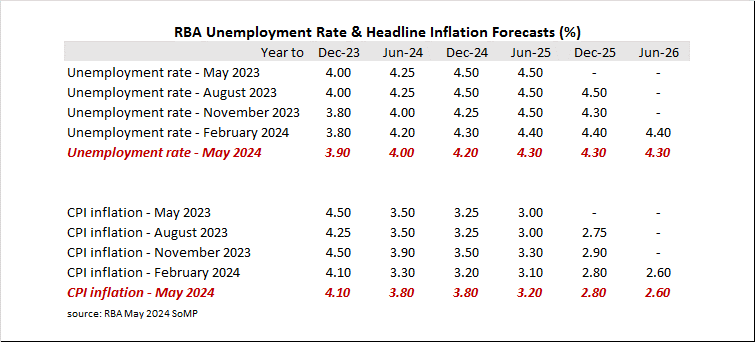Summary: RBA trims GDP forecasts; underlying inflation forecasts raised; jobless rate expected to stay lower for longer; headline inflation forecasts raised; ACGB yield fall; rate-cut expectations firm; ANZ: hurdle to another rate rise could be higher than previously expected.
The Statement on Monetary Policy (SoMP) is released each quarter and it is closely watched for updates to the RBA’s own forecasts.
In February’s SoMP, the opening sentence of the “Global Outlook” section stated the overall outlook was little changed from that of November 2023, “with stronger forecast growth in the United States and high-income economies in east Asia offset by weaker growth in some other advanced economies.”
As far as Australia was concerned at the time, “Economic growth is expected to remain subdued in the near term as inflation and earlier interest rate increases weigh on demand.”
May’s “Global Outlook” is largely a repeat of February’s view. “The overall outlook for growth in Australia’s major trading partners in 2024 is little changed. The stronger forecast growth in 2024 in the United States and China…is offset by downward revisions to growth in New Zealand, Japan and some middle-income economies in east Asia.
From a domestic view, this latest SoMP stated almost exactly the same sentence as in February, except it replaces “near term” with “over most of 2024” and adds “with the outlook a little weaker than three months ago.”
As a result, the RBA’s GDP growth forecasts for the year to June 2024 have been trimmed by 0.10 percentage points while the growth forecast for the year to December 2024 has been lowered by 0.20 percentage points.
“The near-term downgrade to GDP reflects a softer near-term outlook for household consumption and dwelling investment.”
However, even with lower GDP forecasts over 2024, the RBA’s underlying inflation forecasts have been raised somewhat for the years to June 2024, December 2024 and June 2025. Accordingly, the RBA now expects inflation to move below the top of its target range six months later than forecast in February.
“Despite seeing further progress on disinflation in year-ended terms, the pace of disinflation has slowed in recent quarters. This slowing, together with inflation being still too high, is consistent with the assessment that the labour market has remained tight, that output has been above potential, and domestic cost growth has been high.”
The RBA’s view of the unemployment rate typically follows from its forecasts of GDP growth. The unemployment rate has been mostly fluctuating between 3.50% and 3.90% during 2023 and early 2024 but the RBA now expects it to not really rise noticeably above 4% until the end of 2024.
“Growth in employment is forecast to be below growth in the working-age population for a time, resulting in the forecast gradual increase in the unemployment rate. The labour force participation rate is expected to decline slightly alongside the cyclical slowing in the economy.”
Headline inflation forecasts have been raised by 0.50 percentage points for the year to June 2024 and by 0.60 percentage points for the year to December 2024. Periods farther out have also been raised in a minor fashion or left unchanged.
“The recent rise in petrol prices and unwinding of electricity rebates are each expected to add 0.25 percentage points to year-ended headline inflation in the December quarter of 2024.”
The statement came out at the same time as the latest RBA policy decision and Commonwealth Government bond yields declined for a fourth consecutive day, noticeably outpacing the falls of US Treasury yields overnight. By the close of business, the 3-year ACGB yield had shed 11bps to 3.91%, the 10-year yield had lost 7bps to 4.32% while the 20-year yield finished 6bps lower at 4.63%.
In the cash futures market, expectations regarding the cash rate cuts over the next 12 months firmed. At the end of the day, contracts implied the cash rate would remain close to the current rate for the next few months and average 4.29% through June and 4.27% in July. However, November contracts implied a 4.16% average cash rate, February contracts implied 4.07%, while May 2025 contracts implied 3.98%.
“We are conscious about reading too much into RBA forecasts and communication,” said ANZ Head of Australian Economics Adam Boyton. “Still, the combination of the less hawkish than expected language in the post-meeting statement and the larger than expected upward revisions to the RBA’s inflation forecasts over the next few quarters implies the hurdle to another hike could be higher than markets have been expecting heading into this meeting.”



